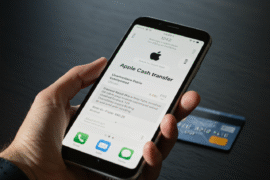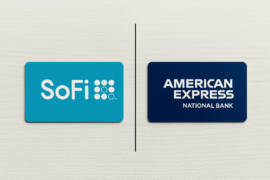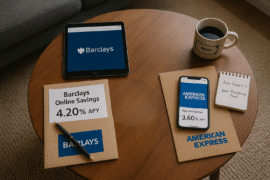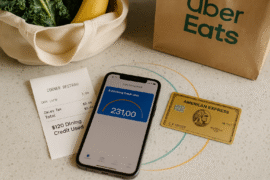This article may contain references to products or services from one or more of our advertisers or partners. We may receive compensation when you click on links to those products or services. Nonetheless, our opinions are our own.
The information presented in this article is accurate to the best of our knowledge at the time of publication. However, information is subject to change, and no guarantees are made about the continued accuracy or completeness of this content after its publication date.

Updated by Albert Fang
Transferring money costs money. The reason for that is because we rely on expensive infrastructure like SWIFT and Visa to keep our money safe. But whether we’re getting good value for money in return is not something that is not regularly considered.
When we send money from one bank to another, it’s free and fast – even when it’s to a different banking company. But, when that bank is in a different country, suddenly we’re expected to wait up to a week and pay ~$50 in wire fees. If you’re unlucky enough that the recipient country has a different currency to yours, then there’s more bad news. The exchange rate that banks provide is usually between 3% to 6% worse than the real rate that they have access to. In other words, a profit margin for them and yet another steep fee for you.
For decades, this was normal and seemed fair. It wasn’t until the money transfer industry really shook things up, and fintech companies kept springing up offering rapid transfers at the click of a button for no fee, and almost a perfect exchange rate (and particularly for large international money transfers).
Shining a light on how bad of a deal we were getting from banks is the motivation behind this guide. We will examine all of the alternative ways to send large amounts of money abroad, and ultimately, the best way to transfer large amounts of money.
What is a money transfer company?
A money transfer company is a company that is focused totally on letting customers send and receive money from around the world. This specialization is one of the key drivers in their competitive success, because it has gotten to a stage where many are fee-free and can charge below 1% markups regarding the exchange rates.
Though, it’s quite as simple as that. Whilst many are completely stripped back, automated, and app-centric, there are also more traditional broker-style companies that shift large amounts abroad. These would be the companies to go to when looking at how to transfer a million dollars internationally, because they provide you with a free dedicated dealer and sophisticated solutions (like hedging). When you send large amounts, you need this added layer of protection.
Regardless of their approach, all money transfer companies have similarities. They all compete mostly on price, have lower overheads than banks, and they’re pretty much all cheaper and faster than a bank when it comes to international transfers. Not being a bank has many advantages, but we should point out that a lack of a banking license also means there’s no FSCS/FDIC deposit protection. They’re not in the business of upselling you on debt products, overdrafts, and credit cards – they’re there for one reason only.
Besides having lower overheads and better specialization, money transfer companies can also offer cheaper rates because they’re not restricted to SWIFT. They use it if they want to, but a company like Moneycorp will have clients all around the world. So, they can operate internally for some of the transfers (i.e. not actually moving money across borders, but debit/credit account balances simultaneously.) There’s a complex system that underpins how they decide which is the optimal way to make each transfer, but this flexibility and versatility is simply more efficient. There are zero legacy systems here holding them back.
Multi-currency wallets
It’s not all about transferring large sums of money abroad, there’s more potential than that. Many money transfer companies have multi-currency wallets, meaning we can hold money around the world in different currencies.
Perhaps we want to purchase a product or service abroad, not send money. Now we are in the territory of an oligopoly: Visa and MasterCard. These companies connect with banks to deliver funds, but will also charge a fee for the recipient and a pricey exchange rate markup.
If it’s an American consumer looking to import high-end German headphones, they can simply open a German (or any Euro-based country) virtual bank account on the money transfer app. It takes seconds. Now, they can make the exchange from USD to EUR on their own terms (i.e. they can time the FX market if they wish) – again, taking seconds. The money could now either be transferred or purchased using a spending card (like Wise, who uses Visa).
This Visa-based secure purchase is now completed in the same currency, which avoids poor exchange rates. Plus, you don’t even need their physical card if you’re short on time, you can simply create a virtual bank card that has a 16-digit number and CVV. The details will be on the app in… you guessed it, seconds.
The same goes for receiving money too. An online US business may receive GBP for some products. On Amazon or similar, they may have an internal exchange that’s expensive and out of their control. But, if they have a GBP virtual bank account to receive payments into, they can take full control over any exchange of currency that is made. Or, they could choose not to make any exchange and accumulate more GBP. A one-off, bulk transfer will bargain you a better exchange rate at most brokers like OFX and WorldFirst.
Why you should use two money transfer companies
As mentioned earlier, money transfer companies often solve two different issues. And, when following the logic of staying away from banks because they’re not specialists, we should apply the same logic to money transfer companies too. This is why you may want two companies for two different needs, one for smaller transfers and one for larger-sum transfers.
Frequent, small transfers
This category of transfers suits the digital nomad types, small businesses, online shoppers, and expats. These are perfect for day-to-day spending, a slick app-centric experience, and having multi-currency accounts around the world.
Wise is the embodiment of this category. Users get a consistent, small fee, which can provide great exchange rates even when sending $5. Customers get a Visa spending card as mentioned earlier, which is great for spending money abroad in restaurants and shops – it works just the same as any other Visa bank card. You don’t even need to exchange the money beforehand, it will do it in real-time at almost the perfect exchange rate with fees as low as 0.5%.
Voted "Best Overall Budgeting App" by Forbes and WSJ
Monarch Money helps you budget, track spending, set goals, and plan your financial future—all in one app.
Get 50% OFF your first year with code MONARCHVIP
Large, sophisticated transfers
Wise would still be sufficient for sending $1,000 overseas, but any more than that and you would have to question if it’s worth signing up to a specialist in larger transfers. OFX, WorldFirst, and Currencies Direct are good examples of specialists, and they all have over-the-phone dedicated specialists, unlike Wise. they may not be great for sending $100, but the rate you receive will get more and more competitive the larger the sum – a bit like bulk-buying at Costco.
It’s not just about the exchange rate and fees, it’s also about avoiding mistakes and currency risk. Large transfers are often driven by investments or big purchases that could take some time, like buying a house. Do we exchange now in preparation for the deal, at the time of the deal, or perhaps hedge to lock in a pre-agreed rate? What if the deal falls through? Perhaps an options contract would be the solution…
These are the questions that brokers can answer for you, and even execute on your behalf.
How does crypto fit into all of this?
Many crypto enthusiasts will be quick to point out that the most efficient system for sending money overseas is blockchain. And, in isolation, it’s difficult to argue with as the technology is truly powerful.
There are some initial concerns regarding safety. For example, what if you want a refund, or to raise suspicion over a transfer and ask for it to be investigated? There may be some DeFi and NFT products that try to deal with these issues, but they’re in their infancy.
But the biggest issue is that crypto doesn’t exist in a vacuum. If it did, then the no markup and no fee would be compelling. But, do you only operate with crypto, and therefore already have the funds, or do you need to exchange some fiat (i.e. USD) to make the transfer? There’s a small chance some do, but there’s a minimal chance that the recipient also operates solely with crypto and will not be exchanging to fiat on the other end.
If you have ever used the big exchanges like Coinbase or Binance, you will know just how expensive it is to convert fiat to crypto and vice-versa. You’re looking at a 3%+ commission/markup on both sides, which can end up costing more than a high street bank.
If no immediate exchange to and from fiat is made, then we still need to consider currency risks. The crypto you’re using has a much higher chance of crashing to half its value next week than the US dollar does. The longer we put off the pricey exchange to/from fiat, the more risk we run of the coin crashing.
E-wallets (Paypal, Payoneer)
E-wallets like PayPal and Payoneer should sound promising in regards to overseas transfers. After all, they avoid SWIFT and other expensive systems, they act internally, and they’re tech-focused. Yet, somehow they have managed to end up being as expensive as high street banks.
PayPal, for example, takes the real exchange rate then applies a 4.5% “conversion service fee charge”. This would render a high-volume low-margin online business completely unprofitable and is truly inexcusable. The security we get in return for PayPal is decent, but it’s not that of a bank, yet some banks even are charging less than this.
PayPal is convenient, sure, but no more so than a money transfer company. Overseas sellers often say it’s an easy way to accept sales revenue. But is it? It’s possible to set up a virtual bank account in countries around the world in a matter of seconds. PayPal, on the other hand, makes it impossible to deal with multiple currencies at once.
Summary
To conclude, high street banks have been getting away with extortionate fees and slow processing times for too long. E-wallets were introduced to combat banking inconveniences, but completely failed to tackle the issue of FX and fees.
The best way to transfer large amounts of money abroad is to use money transfer companies. A large currency transfer should be carried out by a specialist like OFX or Currencies Direct, whilst smaller payments and currency handlings can be done efficiently with the likes of Wise. All of these companies regularly provide a combined commission, fee, and markup that is sub 1%.
Transferring large sums with crypto is a dangerous game. Ignoring the security aspects, there’s an inherent volatility risk that will remain true for many years, and steep exchange markups when converting to/from your base fiat currency. For this reason, we recommend using fintechs that focus on low-cost fiat currency solutions.

Reviewed and edited by Albert Fang.
See a typo or want to suggest an edit/revision to the content? Use the contact us form to provide feedback.
At FangWallet, we value editorial integrity and open collaboration in curating quality content for readers to enjoy. Much appreciated for the assist.
Did you like our article and find it insightful? We encourage sharing the article link with family and friends to benefit as well - better yet, sharing on social media. Thank you for the support! 🍉
Article Title: Transferring Large Amounts Between Banks Across Borders
https://fangwallet.com/2022/10/13/transferring-large-amounts-between-banks-across-borders/The FangWallet Promise
FangWallet is an editorially independent resource - founded on breaking down challenging financial concepts for anyone to understand since 2014. While we adhere to editorial integrity, note that this post may contain references to products from our partners.
The FangWallet promise is always to have your best interest in mind and be transparent and honest about the financial picture.
Become an Insider

Subscribe to get a free daily budget planner printable to help get your money on track!
Make passive money the right way. No spam.
Editorial Disclaimer: The editorial content on this page is not provided by any of the companies mentioned. The opinions expressed here are the author's alone.
The content of this website is for informational purposes only and does not represent investment advice, or an offer or solicitation to buy or sell any security, investment, or product. Investors are encouraged to do their own due diligence, and, if necessary, consult professional advising before making any investment decisions. Investing involves a high degree of risk, and financial losses may occur including the potential loss of principal.
Source Citation References:
+ Inspo












































